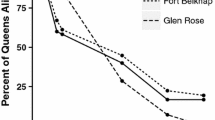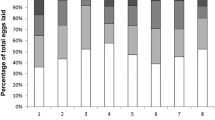Summary
In the fire ant,Solenopsis invicta, some winged virgin queens are known to shed their wings (dealate) upon removal of the mated mother queen. These virgin queens then develop their ovaries and begin to lay eggs, thereby foregoing the option of leaving on mating flights and attempting to found their own colonies. Such a response of virgin queens to queenlessness has not been reported for other ants. In order to determine if virgin queens of some other fire ants (subgenusSolenopsis) would respond in the same way, experiments were conducted onS. richteri, hybridS. invicta/richteri andS. geminata, a member of a species complex different from that of the other taxa. Just as inS. invicta, virgin queens ofS. richteri and the hybrid dealated and began to lay eggs within days of the removal of the queen. In addition, workers executed many of the reproductively active virgin queens, a phenomenon also found inS. invicta. In contrast, virgin queens ofS. geminata did not dealate or quickly begin to lay eggs upon separation from the queen. Reasons for the variability in the response of virgin queens of the different species may be 1) higher probability of reproductive success for unmated dealated queens compared to normal claustral founding inS. invicta andS. richteri linked to relatively frequent loss of the mother queen; or 2) phylogenetic constraint.
Similar content being viewed by others
References
Allen, G. E., W. F. Buren, R. N. Williams, M. de Menezes and W. H. Whitcomb, 1974. The red imported fire ant,Solenopsis invicta: distribution and habitat in Mato Grosso, Brazil.Ann. Entomol. Soc. Am. 67:43–46.
Bourke, A. F. G., 1988. Worker reproduction in the higher eusocial Hymenoptera.Q. Rev. Biol. 63:291–311.
Buren, W. F., G. E. Allen, W. H. Whitcomb, F. E. Lennartz and R. N. Williams, 1974. Zoogeography of the imported fire ants.J. N.Y. Entomol. Soc. 82:113–124.
Choe, J. C., 1988. Worker reproduction and social evolution in ants (Hymenoptera: Formicidae). In:Advances in Myrmecology. (J. C. Trager, Ed), E. J. Brill, Leiden, The Netherlands, pp. 163–187.
Conway, J. R., 1983. A study of winged queens of the Colorado honey ant,Myrmecocystus mexicanus, in captivity.J. N. Y. Entomol. Soc. 91:252–263.
Fletcher, D. J. C. and M. S. Blum, 1981. Pheromonal control of dealation and oogenesis in virgin queen fire ants.Science 212:73–75.
Fletcher, D. J. C. and M. S. Blum, 1983. Regulation of queen number by workers in colonies of social insects.Science 219:312–314.
Fletcher, D. J. C., M. S. Blum, T. V. Whitt and N. Tempel, 1980. Monogyny and polygyny in the fire antSolenopsis invicta Buren.Ann. Entomol. Soc. Am. 73:658–661.
Fletcher, D. J. C. and K. G. Ross, 1985. Regulation of reproduction in eusocial Hymenoptera.Ann. Rev. Entomol. 30:319–343.
Hölldobler, B. and E. O. Wilson, 1990.The ants. Belknap Press of Harvard University Press, 732 pp.
Hung, A. C. F. and S. B. Vinson, 1977. Interspecific hybridization and caste specificity of protein in fire ants.Science 196:1458–1460.
Jouvenaz, D. P., G. E. Allen, W. A. Banks and D. P. Wojcik, 1977. A survey for pathogens of fire ants,Solenopsis spp., in the southeastern United States.Fla. Entomol. 60:275–279.
Passera, L., 1978. Une nouvelle catégorie d'oeufs alimentaires: les oeufs alimentaires émis par les reines vierges dePheidole pallidula (Nyl.) (Formicidae, Myrmicinae).Insectes Soc. 25:117–126.
Ross, K. G. and J. L. Robertson, 1990. Developmental stability, heterozygosity, and fitness in two introduced fire ants (Solenopsis invicta andS. richteri) and their hybrid.Heredity 64:93–103.
Ross, K. G. and J. C. Trager, 1990. Systematics and population genetics of fire ants (Solenopsis saevissima complex) from Argentina.Evolution 44:2113–2134.
Ross, K. G., R. K. Vander Meer, D. J. C. Fletcher and E. L. Vargo, 1987. Biochemical phenotypic and genetic studies of two introduced fire ants and their hybrid (Hymenoptera: Formicidae).Evolution 41:280–293.
Ross, K. G., E. L. Vargo and D. J. C. Fletcher, 1987. Comparative biochemical genetics of three fire ant species in North America, with special reference to the two social forms ofSolenopsis invicta (Hymenoptera: Formicidae).Evolution 41:979–990.
Trager, J. C., 1991. A revision of the fire ants,Solenopsis geminata group (Hymenoptera: Formicidae: Myrmicinae).J. N. Y. Entomol. Soc. 99:141–198.
Tschinkel, W. R. and D. F. Howard, 1978. Queen replacement in orphaned colonies of the fire ant,Solenopsis invicta.Behav. Ecol. Sociobiol. 3:297–310.
Vander Meer, R. K., C. S. Lofgren and F. M. Alvarez, 1985. Biochemical evidence for hybridization in fire ants.Fla. Entomol. 68:501–506.
Vargo, E. L. and D. J. C. Fletcher, 1989. On the relationship between queen number and fecundity in polygyne colonies of the fire ant,Solenopsis invicta.Physiol. Entomol. 14:223–232.
Voss, S. H., 1981. Trophic egg production in virgin queen fire ants.J. Ga. Entomol. Soc. 16:437–440.
Willer, D. E. and D. J. C. Fletcher, 1986. Differences in inhibitory capability among queens of the antSolenopsis invicta.Physiol. Entomol. 11:475–482.
Wilson, E. O., 1971.The Insect Societies. Belknap Press of Harvard Univ. Press, Cambridge, Mass., 548 pp.
Wojcik, D. P., W. F. Buren, E. E. Grissell and T. Carlysle, 1976. The fire ants (Solenopsis) of Florida (Hymenoptera: Formicidae).Florida Department of Agriculture and Conservation Service, Entomology Circular Number 173:1–4.
Author information
Authors and Affiliations
Rights and permissions
About this article
Cite this article
Vargo, E.L., Porter, S.D. Reproduction by virgin queen fire ants in queenless colonies: Comparative study of three taxa (Solenopsis richteri, hybridS. invicta/richteri, S. geminata) (Hymenoptera: Formicidae). Ins. Soc 40, 283–293 (1993). https://doi.org/10.1007/BF01242364
Received:
Revised:
Accepted:
Issue Date:
DOI: https://doi.org/10.1007/BF01242364




